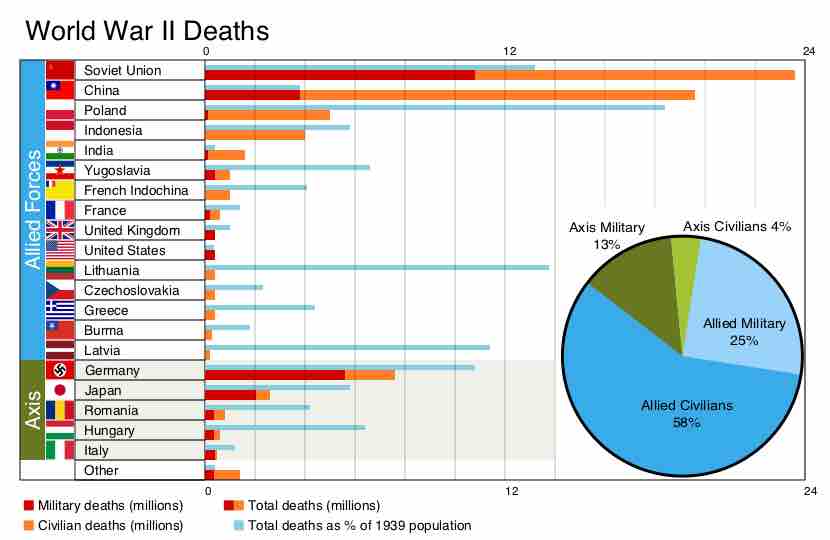ESTIMATIONS CHALLENGES
World War II was the deadliest military conflict in history in absolute terms of total dead. While it is commonly agreed that around 60 million people were killed (about 3% of the 1940 world population,) fatality statistics vary, with estimates of total dead ranging from 50 million to more than 80 million. Compiling or estimating the numbers of deaths caused during wars and other violent conflicts is a controversial subject and historians note that available statistics are often unreliable. One of the challenges is the classification of casualties. Military figures include battle deaths (KIA) and personnel missing in action (MIA), as well as fatalities due to accidents, disease and deaths of prisoners of war in captivity. Civilian casualties include deaths caused by strategic bombing, Holocaust victims, German war crimes, Japanese war crimes, population transfers in the Soviet Union, other war crimes, and deaths due to war related famine and disease. However, the distinction between military and civilian casualties caused directly by warfare and collateral damage is not always clear cut.
The higher figure of over 80 million includes deaths from war-related disease and famine. Civilians killed totaled 50 to 55 million, including 19 to 28 million from war-related disease and famine. Total military dead: from 21 to 25 million, including deaths in captivity of about 5 million prisoners of war.

WWII Deaths
World War II was devastating for both the Allied and Axis nations. Five countries suffered deaths of more than 10% of their population, with Poland leading the tragic statistics with around 18% of population.
NATIONAL STATISTICS
Research in Russia since the collapse of the Soviet Union has resulted in a revision of estimates of Soviet war dead. Estimated USSR losses within postwar borders now stand at around 27 million, including 8.7 million military and 19 million civilian deaths. The largest portion of military dead were 5.7 million ethnic Russians, followed by 1.3 million ethnic Ukrainians. A quarter of the people in the Soviet Union were wounded or killed. In August, 2009, the Polish Institute of National Remembrance (IPN) researchers estimated Poland's dead at between 5.6 and 5.8 million. The German Army historian Dr. Rüdiger Overmans published a study in 2000 that estimated German military dead and missing at 5.3 million, mostly on the Eastern Front and during the final battles in Germany.
For nations that suffered huge losses, such as the U.S.S.R., China, Poland, Germany, and Yugoslavia, sources often give only the total estimated population loss caused by the war and a rough estimate of the breakdown of deaths caused by military activity, crimes against humanity, and war-related famine. Other numbers are often omitted, such as, for example, 19 to 25 million war-related famine deaths in the USSR, China, Indonesia, Vietnam, the Philippines, and India.
Of the total number of deaths in World War II, approximately 85 percent—mostly Soviet and Chinese—were on the Allied side and 15 percent were on the Axis side. Many of these deaths were caused by war crimes committed by German and Japanese forces in occupied territories. An estimated 11 to 17 million civilians died either as a direct or as an indirect result of Nazi ideological policies, including the systematic genocide of around 6 million Jews during the Holocaust, along with a further 5 to 6 million ethnic Poles and other Slavs (including Ukrainians and Belorussians), Roma, homosexuals, and other ethnic and minority groups. Hundreds of thousands (varying estimates) of ethnic Serbs, along with Roma and Jews, were murdered by the Axis-aligned Croatian Ustaše in Yugoslavia and retribution-related killings were committed after the war ended.
In Asia and the Pacific, between 3 million and more than 10 million civilians, mostly Chinese (estimated at 7.5 million), were killed by the Japanese occupation forces.
The mass-bombing of civilian areas, notably the cities of Warsaw, Rotterdam and London, including the aerial targeting of hospitals and fleeing refugees[335] by the German Luftwaffe, along with the bombing of Tokyo, and German cities of Dresden, Hamburg and Cologne by the Western Allies may be considered as war crimes. The latter resulted in the destruction of more than 160 cities and the death of more than 600,000 German civilians. However, no positive or specific customary international humanitarian law with respect to aerial warfare existed before or during World War II.